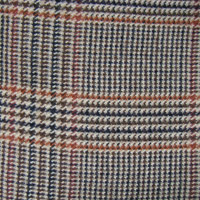Tweed
Tweed is a rough, woolen fabric, of a soft, open, flexible texture, resembling cheviot or homespun, but more closely woven. It is usually woven with a plain weave, twill or herringbone structure. Colored twists of wool are often woven into the fabric to create a heathered or mottled appearance. Traditionally used for upper-class country clothing like shooting jackets, tweed is now used in a variety of apparel, including outerwear, trousers, and suits, as well as in interiors and for upholstery.
History[edit | edit source]
The origins of tweed are rooted in the Scottish Highlands, where it was developed as a durable and weather-resistant fabric for the farmers and outdoor workers. The name "tweed" is believed to have come about as a misreading or misinterpretation of the Scottish word "tweel," which is the Scots word for twill, the fabric's traditional weave. Another theory suggests the name comes from the River Tweed that flows through the Scottish Borders textile area. The fabric gained popularity in the 19th century when members of the British aristocracy began wearing it for hunting and outdoor sporting activities.
Manufacturing Process[edit | edit source]
The manufacturing of tweed involves several steps, starting with the dyeing of raw wool, then spinning it into yarn. The wool can be dyed in various colors before it is spun to create intricate patterns and colors in the finished fabric. After spinning, the wool yarn is woven into tweed on looms. The woven tweed is then finished through a process called 'waulking', which cleans, thickens, and shrinks the fabric, enhancing its texture and durability.
Types of Tweed[edit | edit source]
Several types of tweed have evolved, each with unique characteristics:
- Harris Tweed: Handwoven by the islanders at their homes in the Outer Hebrides of Scotland, made from pure virgin wool dyed and spun in the Outer Hebrides.
- Donegal Tweed: Originating from County Donegal in Ireland, known for its heavy weight and incorporation of multicolored flecks.
- Shetland Tweed: Made from the wool of Shetland sheep, lighter and softer than other tweeds.
- Herringbone Tweed: Characterized by its distinctive V-shaped weaving pattern.
- Check Tweed: Features a checkered pattern, often in earthy tones.
Uses[edit | edit source]
Tweed has been traditionally used for outdoor activities such as hunting and shooting due to its durability and resistance to harsh weather. However, its use has expanded over time to include casual and formal attire, such as suits and jackets, as well as in home decor and upholstery. Its versatility and timeless appeal have made it a staple in both men's and women's fashion.
Cultural Significance[edit | edit source]
Tweed is more than just a fabric; it represents a blend of tradition and style that has transcended its rural origins to become a symbol of sophistication and elegance. It is associated with the British country gentry and the Ivy League style in the United States, embodying a classic, understated fashion sense. The fabric also plays a significant role in Scottish heritage and economy, particularly through the production of Harris Tweed, which is protected by law to ensure its authenticity and quality.
Navigation: Wellness - Encyclopedia - Health topics - Disease Index - Drugs - World Directory - Gray's Anatomy - Keto diet - Recipes
Search WikiMD
Ad.Tired of being Overweight? Try W8MD's physician weight loss program.
Semaglutide (Ozempic / Wegovy and Tirzepatide (Mounjaro / Zepbound) available.
Advertise on WikiMD
WikiMD is not a substitute for professional medical advice. See full disclaimer.
Credits:Most images are courtesy of Wikimedia commons, and templates Wikipedia, licensed under CC BY SA or similar.Contributors: Prab R. Tumpati, MD






